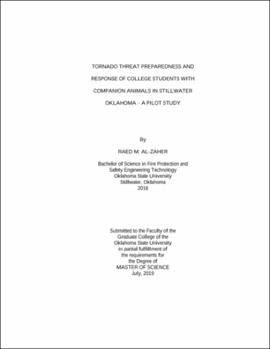| dc.description.abstract | Today, pet owners occupy 62% of households in the United States, and research suggests that number is on the rise (APPA 2018). The objective of this study is to explore the factors that affect risk perception, protective action, preparedness, and sheltering awareness of college students with pets with regard to a natural onset disaster, such as a tornado. This project also aims to provide tools to assist emergency mangers to understand how pet owners perceive natural disaster risks to themselves and their animal(s) and thereby guide their choices to take action. This project explores Trigg's (2015) and Thompson's (2016) notion of "pets as a protective action factor", where pet owners chose to act differently in emergencies because of the bonds to their pets. A theoretical lens, Protective Action Decision Model (Lindell, 2018), is used to establish hypothesis testing. This research was conducted in the form of an online controlled experiment and survey, with help from Oklahoma State University (OSU). It involved 119 OSU college students taking part in a computer simulation of tornado threat and a multiple choice questionnaire. The simulation (powered by DynaSearch) provided context of the danger to participants through visual (images) and written (text) information sources. After being allowed five minutes to view the information, the following questionnaire assessed participants' risk perception, their choices of protective action, pet preparedness, and awareness levels regarding peer and public shelters. Analysis of the data gathered through this experiment also compared the effects of demographics characteristics (age, education, cognitive abilities, and experiences) on pet disaster preparedness. The findings suggest strong pet preparedness predictors on the basis of respondents' age and direct tornado experience. Although the information from this pilot study is specific to Oklahoma State University students, the student community is a group with high diversity and is a valuable sample. Also, this experiment provides new tools that may be used for further research, possibly including larger groups and different disasters. Designing direct and clear messages targeted specifically at pet owners' concerns will help reduce the number of human and animal potential disaster victims, of special concern with increasing pet populations. | |
